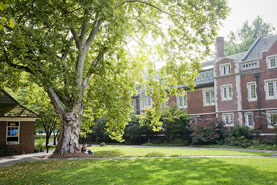
IRIS login | Reed College home Volume 96, No. 2: June 2017
Reed Shrinks Carbon Footprint
In a move that will significantly reduce its environmental impact, Reed has signed a three-year, $5.4 million contract with Ameresco Quantum to identify and implement changes that will minimize energy use, maximize equipment life and maintain building livability.
After evaluating more than 960,000 square feet of campus buildings, AQ outlined a program of energy renewal and replacement that will yield a 12% reduction in electrical energy use, a 13% reduction in gas use and a 28% reduction in water and sewer costs. The changes are estimated to cut operational utility costs by at least $2.7 million over the next 10 years and reduce annual CO2 emissions by 2.65 million pounds.
In addition to identifying the issues, AQ will oversee the improvement projects, negotiating work contracts and insuring timely completion. Reed’s contract with the company establishes a “not to exceed” price for the work, with AQ paying for any cost overruns.
Work is already underway in the Library, Chemistry, Education Technology Center, Eliot Hall, Vollum College Center, Sports Center, Gray Campus Center, and the Physical Plant. Energy Trust of Oregon is funding $300,000 of this work.
Six years ago Reed adopted a sustainability mission statement that recognized the relationship between the campus and the planet. A committee was formed to field sustainability proposals—everything from building a cob bicycle shelter to investing in wind power.
“We quickly found out that there are a whole bunch of $100,000 to $200,000 things you can do that are not going to have any real impact,” says committee member Townsend Angell, director of facilities operations. “We need to prudently manage the money that is given to Reed. We don’t really know the future of wind power. But we can invest in a piece of equipment, like a boiler, that works better and makes an impact we can measure.”
The committee began to focus on projects that would result in measurable energy savings. One of the projects AQ identified is installing a new, more efficient steam boiler to reduce energy costs and help preserve the old boilers.
Angell says the massive old boilers are “in ridiculously good condition,” but are really designed to perform optimally on 40-degree days. In the summer, when the biggest loads are heating the pool and the dining room steam tables, the big boilers are constantly starting and stopping, which consumes energy and promotes wear and tear to their components. The smaller boiler will handle summer loads more efficiently and provide opportunities to perform maintenance on the big boilers so they run more efficiently.
The boilers provide heat for many buildings on campus, including the Physical Plant, the Sports Center, Commons, Foster-Scholz, MacNaughton, the Old Dorm Block, Cross Canyon, Eliot Hall, Vollum College Center, the Library, and the psychology, biology, physics and chemistry buildings. Both the chemistry building and the library have stand-alone boilers if the need arises.
By contrast, each room in the four Grove dorms has its own thermostat, with a system that is able to heat one room as it cools another. Heat is harvested from parts of the building that don’t want it and delivered to parts that do without consuming more energy.
Motion detectors to start and stop fans and lights are already used in dorm bathrooms. New sensors triggered by carbon dioxide will be installed in places like Kaul Auditorium to notify the heating system when people arrive. Programmable at variable frequency drives, the sensors can measure the number of people in the room by the carbon dioxide they exhale and adjust the air intake accordingly.
Other campus-wide improvements include replacing conventional light bulbs with LEDs and replacing tank toilets with low-flush toilets that use pressure and not gravity to clear the bowl and use much less water. Showers across campus are being fitted with water-saving showerheads and sink faucets outfitted with flow-limiting aerators.
Solar panels have already been installed on the roof of the Theatre Annex to offset the energy consumption of that building, the two warehouses, Birchwood Apartments, Reed College Apartments, the Health and Counseling Center, 28 West, and the Farm, Garden, and Canyon houses.
As a nonprofit institution, the college isn’t eligible for the tax incentives that offset the high cost of installing solar panels. It has contracted with a for-profit company that qualifies to take advantage of the tax incentives to install and maintain the panels. That company sells the energy to the college at 3% less than PGE’s monthly price.
Some institutions offset their carbon footprint by purchasing energy credits from others with a lower footprint. Angell says Reed’s approach not only authentically reduces the campus carbon footprint, it reduces utility bills.
Tags: sustainability, Portland, carbon footprint



LATEST COMMENTS
steve-jobs-1976 I knew Steve Jobs when he was on the second floor of Quincy. (Fall...
Utnapishtim - 2 weeks ago
Prof. Mason Drukman [political science 1964–70] This is gold, pure gold. God bless, Prof. Drukman.
puredog - 1 month ago
virginia-davis-1965 Such a good friend & compatriot in the day of Satyricon...
czarchasm - 4 months ago
John Peara Baba 1990 John died of a broken heart from losing his mom and then his...
kodachrome - 7 months ago
Carol Sawyer 1962 Who wrote this obit? I'm writing something about Carol Sawyer...
MsLaurie Pepper - 8 months ago
William W. Wissman MAT 1969 ...and THREE sisters. Sabra, the oldest, Mary, the middle, and...
riclf - 10 months ago